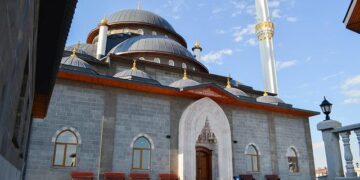ByJoe Pappalardo
Published June 30, 2023
• 11 min read
Don Liebenberg gazed from the window of the Concorde supersonic airplane, watching the shadow of the moon streaking across the Sahara Desert. The horizon looked bent: At 58,000 feet, the airplane’s passengers could clearly see the curvature of the Earth. Above them in the sky, unseen but for an image projected on a sheet of paper on the floor, was the ghostly ring of a total solar eclipse.
On June 30, 1973, Liebenberg was one of seven researchers who experienced the longest airborne total eclipse observation ever recorded: 74 minutes of totality. At twice the speed of sound, the Concorde kept pace with the eclipse’s umbra, the darkest part of the moon’s shadow, where the entire sun is blocked.
The high altitude enabled the onboard infrared and optical cameras, installed in roof portholes, to capture details of the sun’s rim, called the corona, with little atmospheric interference. Studying the corona can help reveal how heat and energy are transferred from the sun into the solar system. This steady stream of particles, called the solar wind, sometimes blasts out with greater intensity due to eruptions in the corona, with the potential to damage spacecraft as well has electrical hardware on Earth’s surface.
“Our results could at that time only be obtained with a supersonic aircraft,” says Liebenberg, now an adjunct professor of physics and astronomy at Clemson University. The record-breaking flight made global headlines, and the Concorde that flew the mission has been enshrined in its eclipse-chasing variant at the French National Air and Space Museum. But solar researchers acknowledge that the flight only had a modest impact on our understanding of the sun.
“The 1973 Concorde flight was certainly one of the more audacious and compelling eclipse expeditions,” says Kevin Reardon, a scientist at the National Solar Observatory who studies past and future eclipses. “However, the importance of its results probably don’t quite match the extent to which it continues to capture our imagination.”
For Jenna Samra, a researcher at the Harvard & Smithsonian Center for Astrophysics who’s leading a scientific flight to observe the 2024 total solar eclipse from a Gulfstream V jet, the 50-year-old mission means more than just nostalgia. “Some of their science goals were the same as our modern ones,” she says. “At a minimum, the fact that we’re still doing it shows that it’s teaching us quite a lot.”
High altitude totality
People have been chasing eclipses in airplanes since at least 1925. Detailed measurements of the solar corona are virtually impossible from the ground because Earth’s atmosphere blocks and distorts observations. By the mid-1960s, rockets and balloons had also been used to make eclipse measurements, but these flights only experienced totality for fleeting minutes.
In the late 1960s larger jet aircraft were designed to fly beyond the sound barrier, and the possibilities for solar science intrigued Liebenberg. “I organized a conference to discuss the possible use of the Air Force’s XB-70 supersonic jet for eclipse observations,” he says. The XB-70, a retiring testbed used to create the SR-71 Blackbird spy plane, would have required too much retrofitting to use for space science. However, a civilian supersonic jet soon offered what Liebenberg was looking for: the Concorde SST.
The first testbed, Concorde 001, flew in March 1969. Three years later Liebenberg and fellow Los Alamos scientist, Art Cox, wrote to the French Institut National Astronomic et Geophysique to request the Concorde prototype be used to observe the solar corona during a total eclipse. Thanks to some help from French and British astronomers, the flight was approved. It would take place just before the prototype airplane was to be retired, before commercial service started.
By January 1973 Liebenberg was preparing for the flight in Paris and Toulouse, and by April his specialty equipment had been built and delivered. “It was a remarkable process, with many hands to support us at the LANL,” he said, still grateful five decades later. Portholes were carved into Concorde 001’s skin to accommodate the cameras, and the unneeded passenger seats were stripped to make room for equipment.
At the top of Liebenberg’s list of observations was to time the cycles of solar intensity. Periodicity, as it’s called, had been observed on the solar surface in the late 1960s but had never been recorded and confirmed over a long length of time.
The Concorde took off from the volcanic island of Gran Canaria, in the Canary archipelago, and chased the moon’s shadow across Africa. The team witnessed 74 minutes of continuous totality and enjoyed a second, 7-minute totality, as well as a third of 12 minutes. They used these second and third forays into the moon’s shadow to capture imagery from even higher altitudes.
As planned, the team were the first to capture long-duration images of the rhythmic pulsing of the corona’s light. “Our results provided the first indication of a five-minute periodicity,” Liebenberg says.
Upon landing in Chad, French test pilot André Turcat informed an Associated Press of the successful flight. Newspapers around the world printed the eclipse images and a short French documentary was made from the footage.
But as time went on, no major revelations were announced. The experiments on the Concorde produced results that went largely unused. Even measuring the five-minute oscillations in coronal intensity didn’t spark any further scientific insights. “Strangely no significant results were ever published from the effort,” says the National Solar Observatory’s Reardon, who is also an adjunct astronomy professor at the University of Colorado Boulder.
The experiments created large amounts of imagery on film. “To be useful for analysis, much of the data would need to be converted into digital formats, at significant cost,” Reardon says. “Serge Koutchmy told me a few years ago that he had several hundred 35mm film images from the flight that have never been digitized,” he says, referring to one of the mission participants who died in May 2023.
“The overall science output was not as notable as the flight itself,” Reardon summed up.
While the scientific results may have been less than revolutionary, the final flight of Concorde 001 truly pushed the envelope for aerial solar observation. The mission objective, flying in the path of totality for as long as possible, remains relevant for eclipse research today.
The Concorde itself, however, was doomed to be a niche aircraft. After a fatal crash in 2000 and a well-earned reputation for obscene fuel consumption, commercial flights of the Concorde ended in 2003. There has not been a supersonic airliner in operation since.
Eclipse chasing in the 21st century
Samra, the Center for Astrophysics researcher planning a new eclipse chase in a Gulfstream V, admitted she knew little of the 1973 flight. After looking at the earlier effort, she recognized similarities in their approach. Like the 1973 team, she isn’t planning to verify pre-existing ideas; she’s out to try to find something new. “The fact that it was so exploratory, that’s one parallel,” Samra says.
Her quest is to identify mid-infrared signals that subtly change under the influence of the sun’s magnetic field. If these specific emissions can serve as diagnostic tools, they could be used to discern when regions of the magnetic field start to store energy, a precursor to violent mass ejections.
Today, there are more ways than ever to observe the corona, including continuous satellite coverage at ultraviolet or x-ray wavelengths and scans with coronagraphs that block the sun’s disk, such as on the Inouye Solar Telescope in Hawaii. But there’s still an important role for infrared imagery, which can capture details that are not visible in other wavelengths, such as superheated dust grains that swirl around the sun.
In 2021 Samra flight-tested the Airborne Stabilized Platform for InfraRed Experiments (ASPIRE), a large-aperture solar tracking instrument for the Gulfstream V. During the 2024 North American eclipse, ASPIRE will feed images to a customized spectrometer called AirSpec to examine the sun’s magnetic field patterns at infrared wavelengths. “There have been huge advances in IR detectors, particularly commercially available ones, even in the last two decades,” Samra says. “The measurements we can get were impossible in 1973. And we need that specificity.”
Samra and her team must first prove that there are tiny segments of the infrared spectrum that can be more clearly seen from the air than by existing observatories from the ground. Then those emissions must be validated as solar diagnostic tools in a future high-altitude balloon flight. Only then could a sensor for a satellite be optimized for useful observation—or an early warning system.
Next year Samra will fly at 42,000 feet and enjoy about six minutes of eclipse totality. “I’m jealous of the time they had,” she said of the 1973 flight. “I was on a nine-minute eclipse flight once, and that was just enough time to relax. A little, in the middle.”
Liebenberg—an active astronomer who still keeps an eye on solar corona emissions in addition to studying condensed matter physics—has followed the Gulfstream project’s progress with interest. “I discussed some of their early results in a course for the Osher Lifelong Learning Institute a year or two ago,” he says. “Much more information keeps coming.”
The future is intriguing, but for Liebenberg the past remains clear. Fifty years later, he can still remember passing into the moon’s shadow at Mach 2.2. “The extreme darkness of the sky during totality,” he said. “That was the most memorable.”
>>> Read full article>>>
Copyright for syndicated content belongs to the linked Source : National Geographic – https://www.nationalgeographic.com/premium/article/supersonic-concorde-jet-chased-total-solar-eclipse-across-africa































